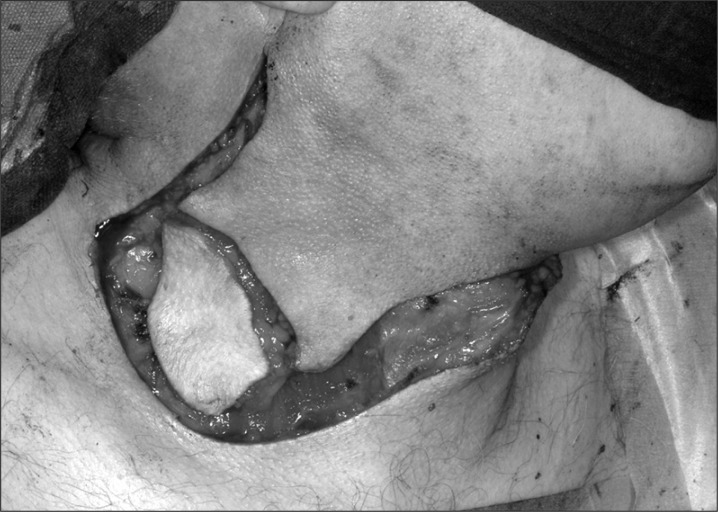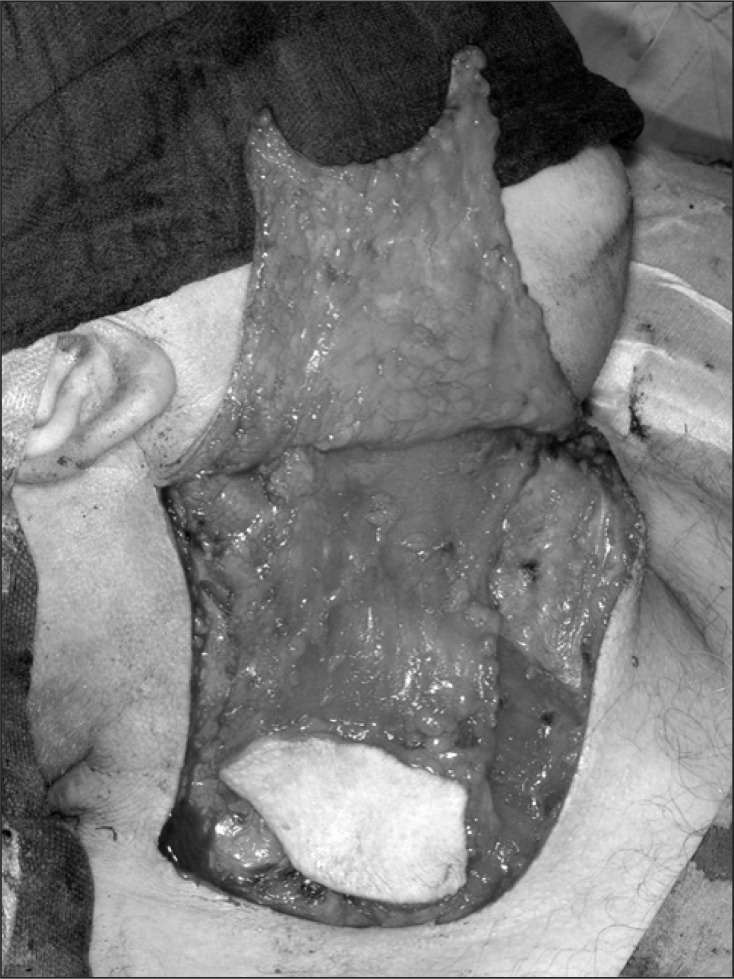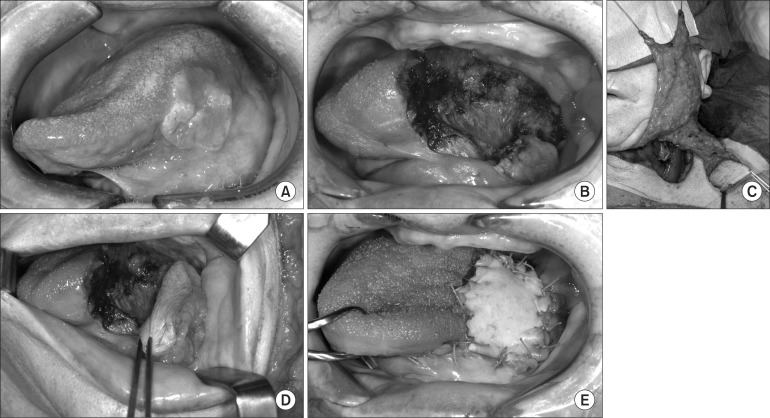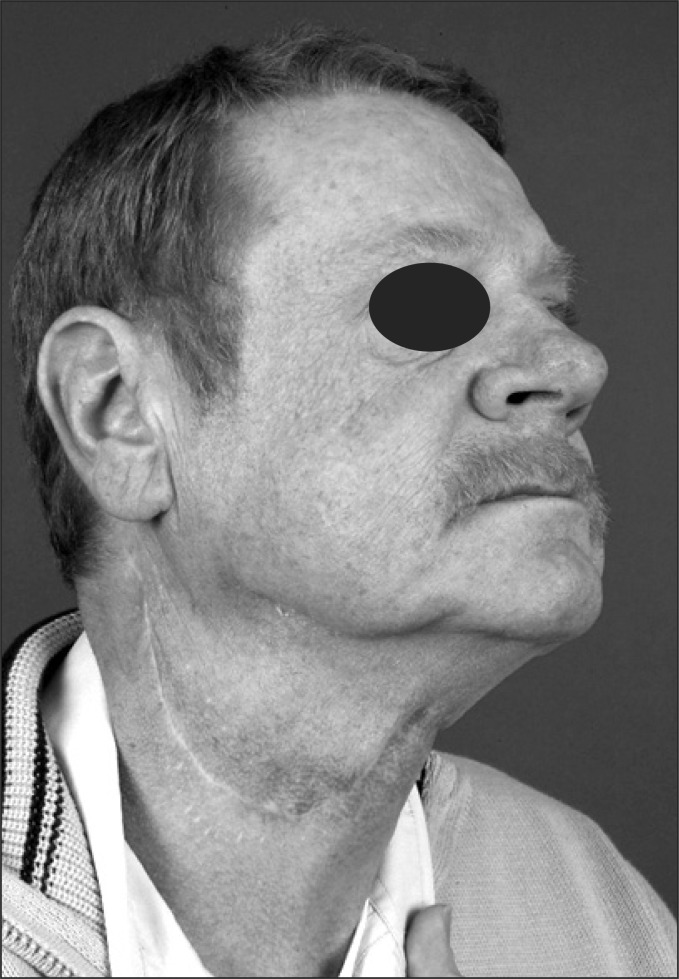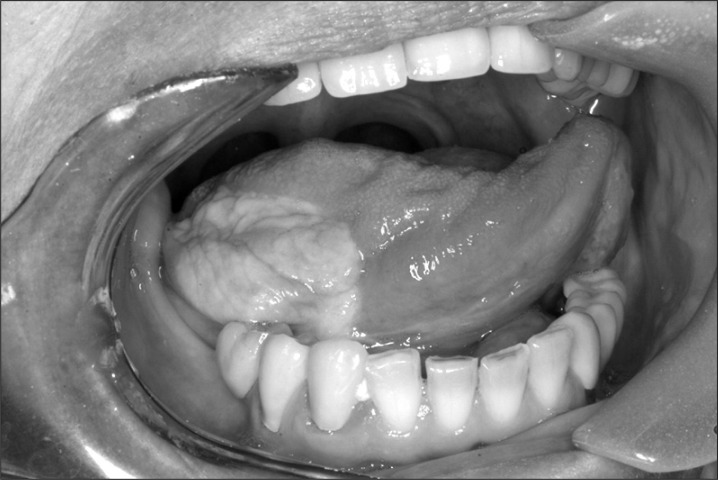J Korean Assoc Oral Maxillofac Surg.
2013 Feb;39(1):3-8. 10.5125/jkaoms.2013.39.1.3.
Platysma myocutaneous flap - its current role in reconstructive surgery of oral soft tissue defects
- Affiliations
-
- 1Department of Cranio-Maxillofacial Surgery, Faculty of Dentistry, Hannover Medical University, Hannover, Germany. eckardt.andre@mh-hannover.de
- KMID: 2189549
- DOI: http://doi.org/10.5125/jkaoms.2013.39.1.3
Abstract
- Reconstruction of oral soft-tissue defects following resection of oral carcinomas can be achieved using various techniques including microsurgical tissue transfer. However, there seems to be a role for regional or local flaps. Small to medium-size defects can be functionally reconstructed with the platysma myocutaneous flap as an excellent choice particularly in medically compromised patients not being eligible for free tissue transfer. The present paper reviews the indication, surgical technique, and complications following reconstruction of defects of the oral cavity with the platysma myocutaneous flap.
Keyword
MeSH Terms
Figure
Reference
-
1. Nakatsuka T, Harii K, Asato H, Takushima A, Ebihara S, Kimata Y, et al. Analytic review of 2372 free flap transfers for head and neck reconstruction following cancer resection. J Reconstr Microsurg. 2003; 19:363–368. PMID: 14515225.
Article2. Eckardt A, Meyer A, Laas U, Hausamen JE. Reconstruction of defects in the head and neck with free flaps: 20 years experience. Br J Oral Maxillofac Surg. 2007; 45:11–15. PMID: 16464523.
Article3. Singh B, Cordeiro PG, Santamaria E, Shaha AR, Pfister DG, Shah JP. Factors associated with complications in microvascular reconstruction of head and neck defects. Plast Reconstr Surg. 1999; 103:403–411. PMID: 9950525.
Article4. Genden EM, Rinaldo A, Suárez C, Wei WI, Bradley PJ, Ferlito A. Complications of free flap transfers for head and neck reconstruction following cancer resection. Oral Oncol. 2004; 40:979–984. PMID: 15509488.
Article5. Shestak KC, Jones NF, Wu W, Johnson JT, Myers EN. Effect of advanced age and medical disease on the outcome of microvascular reconstruction for head and neck defects. Head Neck. 1992; 14:14–18. PMID: 1624289.
Article6. Schusterman MA, Kroll SS, Weber RS, Byers RM, Guillamondegui O, Goepfert H. Intraoral soft tissue reconstruction after cancer ablation: a comparison of the pectoralis major flap and the free radial forearm flap. Am J Surg. 1991; 162:397–399. PMID: 1951897.
Article7. Gersuny R. Plastischer ersatz der wangenschleimhaut. Zentralbl Chir. 1887; 14:706.8. Futrell JW, Johns ME, Edgerton MT, Cantrell RW, Fitz-Hugh GS. Platysma myocutaneous flap for intraoral reconstruction. Am J Surg. 1978; 136:504–507. PMID: 360854.
Article9. Coleman JJ 3rd, Jurkiewicz MJ, Nahai F, Mathes SJ. The platysma musculocutaneous flap: experience with 24 cases. Plast Reconstr Surg. 1983; 72:315–323. PMID: 6611753.10. Cannon CR, Johns ME, Atkins JP Jr, Keane WM, Cantrell RW. Reconstruction of the oral cavity using the platysma myocutaneous flap. Arch Otolaryngol. 1982; 108:491–494. PMID: 7103826.
Article11. McGuirt WF, Matthews BL, Brody JA, May JS. Platysma myocutaneous flap: caveats reexamined. Laryngoscope. 1991; 101:1238–1244. PMID: 1943427.12. Vriens JP. A reappraisal of the platysma myocutaneous island flap. A follow-up study of the functional outcome after reconstruction of the floor of the mouth. Int J Oral Maxillofac Surg. 1995; 24:212–215. PMID: 7594754.13. Manni JJ, Bruaset I. Reconstruction of the anterior oral cavity using the platysma myocutaneous island flap. Laryngoscope. 1986; 96:564–567. PMID: 3702572.
Article14. Posnick JC, McCraw JB. Reconstruction of the chin-lower cheek complex with a platysma myocutaneous flap. J Oral Maxillofac Surg. 1988; 46:152–155. PMID: 3422282.
Article15. Ruark DS, McClairen WC Jr, Schlehaider UK, Abdel-Misih RZ. Head and neck reconstruction using the platysma myocutaneous flap. Am J Surg. 1993; 165:713–718. PMID: 8506972.
Article16. Ozgen K, Berberoglu U, Altinok M, Ozdemir E, Celen O. Reconstruction of full-thickness cheek defects using platysma myocutaneous flaps. Eur J Plast Surg. 1993; 16:208–211.
Article17. Koch WM. The platysma myocutaneous flap: underused alternative for head and neck reconstruction. Laryngoscope. 2002; 112:1204–1208. PMID: 12169900.
Article18. Verschuur HP, Dassonville O, Santini J, Vallicioni J, Poissonnet G, Laudoyer Y, et al. Complications of the myocutaneous platysma flap in intraoral reconstruction. Head Neck. 1998; 20:623–629. PMID: 9744463.
Article19. Tosco P, Garzino-Demo P, Ramieri G, Tanteri G, Pecorari G, Caldarelli C, et al. The platysma myocutaneous flap (PMF) for head and neck reconstruction: a retrospective and multicentric analysis of 91 T1-T2 patients. J Craniomaxillofac Surg. 2012; 40:e415–e418. PMID: 22444352.
Article20. Koch M, Künzel J, Mantsopoulos K, Zenk J, Iro H. Defect closure after oral and pharyngeal tumor resection with the superiorly pedicled myocutaneous platysma flap: indications, technique, and complications. Eur Arch Otorhinolaryngol. 2012; 269:2111–2119. PMID: 22197891.
Article21. Pagani D, Capaccio P, Fontanella W, Sambataro G, Broich G, Pignataro L. Vertical platysma myocutaneous flap reconstruction for T2-staged oral carcinoma. Anticancer Res. 2007; 27:2961–2964. PMID: 17695479.22. Puxeddu R, Dennis S, Ferreli C, Caldera S, Brennan PA. Platysma myocutaneous flap for reconstruction of skin defects in the head and neck. Br J Oral Maxillofac Surg. 2008; 46:383–386. PMID: 18207614.
Article23. Grützenmacher S, Steinmeier E, Hosemann W. The use of the platysma myocutaneous flap for reconstruction in the head-neck area -- a retrospective study. Laryngorhinootologie. 2005; 84:733–737. PMID: 16231240.24. Wang KH, Hsu EK, Shemen LJ. Platysma myocutaneous flap for oral cavity reconstruction. Ear Nose Throat J. 2010; 89:276–279. PMID: 20556740.
Article25. Esclamado RM, Burkey BB, Carroll WR, Bradford CR. The platysma myocutaneous flap. Indications and caveats. Arch Otolaryngol Head Neck Surg. 1994; 120:32–35. PMID: 8274253.
Article26. Su T, Zhao YF, Liu B, Hu YP, Zhang WF. Clinical review of three types of platysma myocutaneous flap. Int J Oral Maxillofac Surg. 2006; 35:1011–1015. PMID: 17000080.
Article27. Ozçelik T, Aksoy S, Gökler A. Platysma myocutaneous flap: use for intraoral reconstruction. Otolaryngol Head Neck Surg. 1997; 116:493–496. PMID: 9141400.28. Lazaridis N, Dimitrakopoulos I, Zouloumis L. The superiorly based platysma flap for oral reconstruction in conjunction with neck dissection: a case series. J Oral Maxillofac Surg. 2007; 65:895–900. PMID: 17448839.
Article29. Baur DA, Helman JI. The posteriorly based platysma flap in oral and facial reconstruction: a case series. J Oral Maxillofac Surg. 2002; 60:1147–1150. PMID: 12378489.30. Ariyan S. The transverse platysma myocutaneous flap for head and neck reconstruction: an update. Plast Reconstr Surg. 2003; 111:378–380. PMID: 12496608.
Article31. Handa Y, Kitajima T, Takagi N, Yasuoka T, Naitoh K, Tatematsu N, et al. The platysma myocutaneous flap for oral reconstruction. Experience with MacFee's cervical incision. J Craniomaxillofac Surg. 1989; 17:318–322. PMID: 2808712.32. Mazzola RF, Benazzo M. Platysma flap for oral reconstruction. Clin Plast Surg. 2001; 28:411–419. PMID: 11400834.
Article33. Hurwitz DJ, Rabson JA, Futrell JW. The anatomic basis for the platysma skin flap. Plast Reconstr Surg. 1983; 72:302–314. PMID: 6611752.
Article34. Uehara M, Helman JI, Lillie JH, Brooks SL. Blood supply to the platysma muscle flap: an anatomic study with clinical correlation. J Oral Maxillofac Surg. 2001; 59:642–646. PMID: 11381387.
Article35. Kocer U, Ozdemir R, Ulusoy MG, Uysal A, Sungur N, Sahin B, et al. Anatomy of the platysma muscle and the evaluation of it for the reconstruction of facial defects. J Craniofac Surg. 2005; 16:463–470. PMID: 15915117.
Article36. Peng LW, Zhang WF, Zhao JH, He SG, Zhao YF. Two designs of platysma myocutaneous flap for reconstruction of oral and facial defects following cancer surgery. Int J Oral Maxillofac Surg. 2005; 34:507–513. PMID: 16053870.
Article37. Szudek J, Taylor SM. Systematic review of the platysma myocutaneous flap for head and neck reconstruction. Arch Otolaryngol Head Neck Surg. 2007; 133:655–661. PMID: 17638777.
Article
- Full Text Links
- Actions
-
Cited
- CITED
-
- Close
- Share
- Similar articles
-
- A clinical study on superiorly based platysma myocutaneous cervical flap for reconstruction following intraoral soft tissue cancer surgery
- Modified Medial Gastrocnemius Myocutaneous Flap Technique for Knee Joint Coverage after Total Knee Arthroplasty
- Reconstruction of Intraoral Defect with Cervical Island Flap
- Anatomical Review of Latissimus Dorsi Free Flap for Oral Cavity and Facial Reconstruction
- Walk-Up flap for Reconstruction of Oral and Maxillofacial defects

